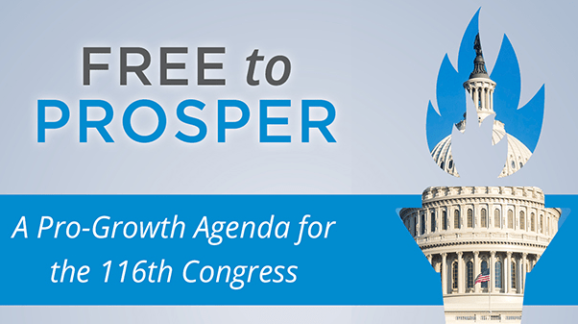Introducing a Free-Market Agenda for Accountability and Prosperity

An introduction to the Competitive Enterprise Institute’s latest study, “Free to Prosper: A Pro-Growth Agenda for the 116th Congress.”
 The governance of American life has been handed over to an operating system that subtly and perversely drives individuals’ behavior away from their own decisions. Unaccountable regulatory agencies dominate how we live, work, play, build, travel, prepare food, and heal one another.
The governance of American life has been handed over to an operating system that subtly and perversely drives individuals’ behavior away from their own decisions. Unaccountable regulatory agencies dominate how we live, work, play, build, travel, prepare food, and heal one another.
Did you know it is a federal crime to sell chewing gum that is more that 0.065 percent beeswax or to sell vegetable spaghetti bigger than 0.11” in diameter? We have all seen the photos of the Federal Register that look like mountains of paper. But what do those pages mean for real people? Typically, regulations do not lead the news and are not an issue that will garner much attention. Yet, virtually every aspect of our lives is regulated by the federal government. With that in mind, there are three central arguments for a thoughtful regulatory agenda in the new Congress.
First, there is Article I of the Constitution, which bestows upon Congress the singular power to legislate. For decades, however, Congress has delegated away much of its lawmaking authority to regulatory agencies. When it reasserts its constitutional authority, Congress is better positioned to deal with issues proactively rather than merely receiving whatever comes from the executive and judicial branches of government. Quite simply, we have a good system for how to set the rules of the game for life in America. It is a system that relies on Congress to make the laws and it is well past time to try it once again.
Regulation is not a salve for political, social, or economic tensions. However, it does crowd out the very institutions positioned to address those essential issues of our time. Regulatory reform is necessary to make room for all the good that comes from the institutions that are the fabric of local communities, such as booster clubs, museums, scholarship funds, and food drives. Those things that enrich our lives are slowly crowded out by the time, money, and attention we must devote to things like the diameter of vegetable spaghetti.
The costs of government extend far beyond what Washington taxes, borrows, and spends. Relatively speaking, fiscal policy is quantifiable and visible. By contrast, we make nearly no effort to assess the tradeoffs or effectiveness of regulatory policy. As a result, it is nearly invisible. Yet, the low-end estimates of the federal regulatory burden are $1.9 trillion per year. That is nearly $15,000 for every household. On average, the typical household spends more on regulatory costs than on any other category of its budget save housing. The 116th Congress has a historic opportunity to bring to light an accounting of how the government operates and what values we pursue through Washington’s edicts.
We have made some progress recently. Congress rediscovered the Congressional Review Act. Through executive order, executive agencies have displayed more consciousness of benefit-cost reviews and “regulatory dark matter.” Regulatory reform ideas proposed by CEI, such as a regulatory budget, have gained acceptance, if not full adoption, in Washington. We will keep pushing for stronger reforms. But we still have a long way to go.
Today we find ourselves in a moment where good ideas—many with bipartisan pedigree—all point toward creating binding limits on the executive branch. Some seek to curtail the current administration. Others would like to see fewer far-reaching rules from unaccountable agencies that receive far too much deference from the courts. Taken together, it is time to move a regulatory reform agenda forward.
This edition of “Free to Prosper” offers some bold, yet practical ideas for regulatory reform that the incoming Congress should tackle. It covers a lot of ground, too much to go into detail here. However, I would like to highlight some key priorities.
Read the rest of Kent’s introduction here, and the full text of “Free to Prosper,” here.